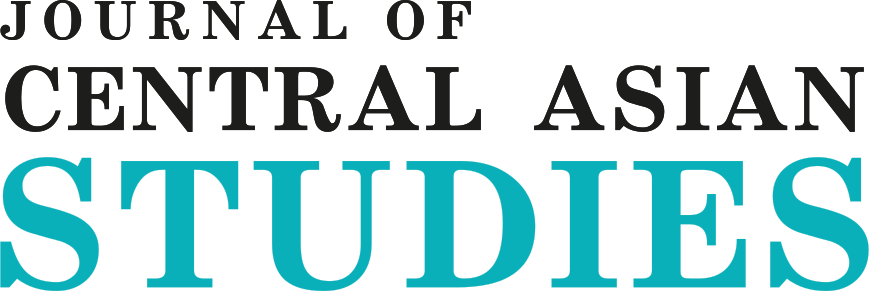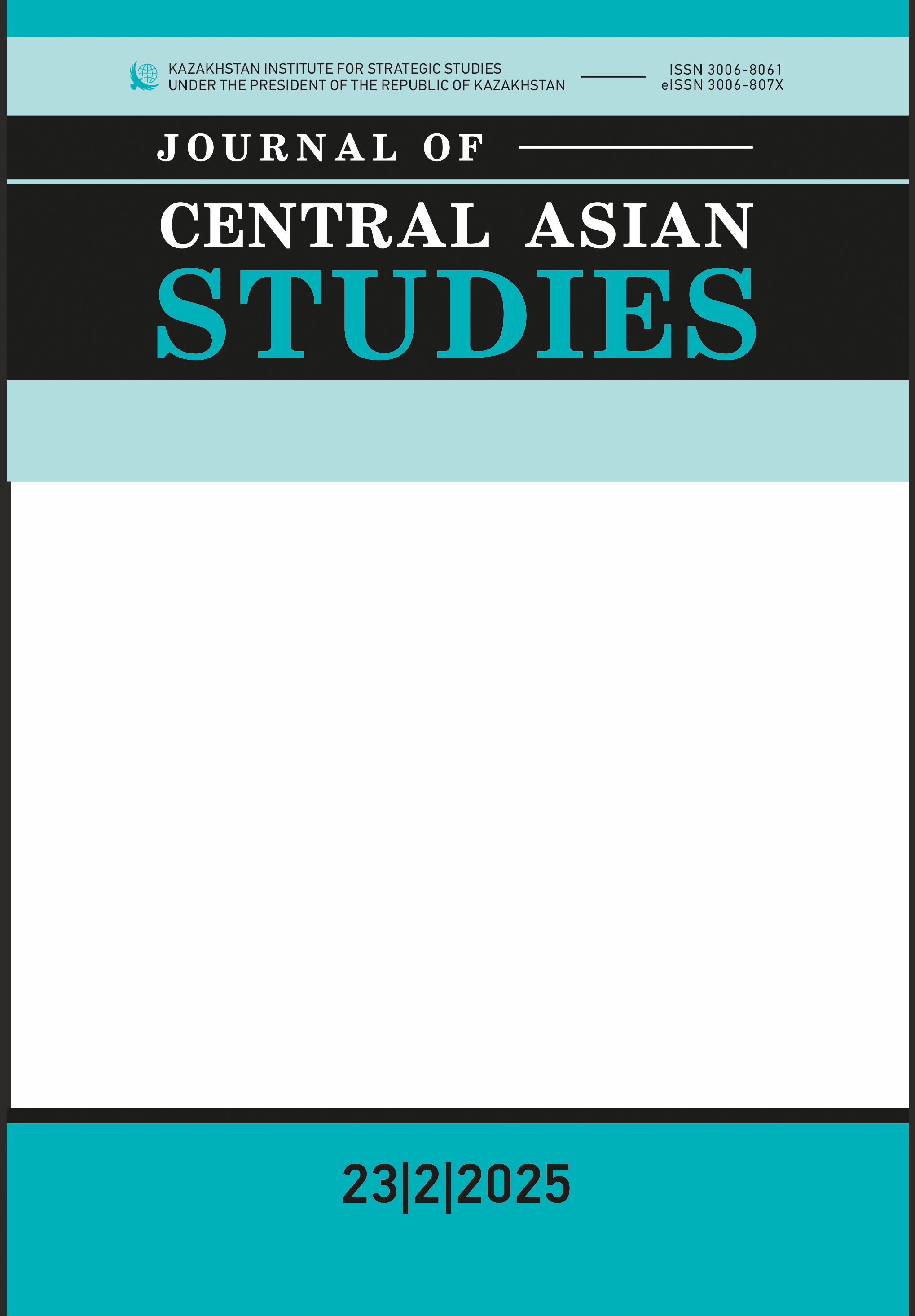Determinants of European Union Foreign Direct Investment in Central Asia
DOI:
https://doi.org/10.52536/3006-807X.2025-2.006Keywords:
Central Asia, determinants, European Union, foreign direct investmentAbstract
This article explores the key factors that impact the foreign direct investment of the European Union in Central Asia. The study analyzes a panel data set of five Central Asian countries - Kazakhstan, Kyrgyzstan, Uzbekistan, Turkmenistan, and Tajikistan - between 2013 and 2022 to examine the correlation between EU FDI and seven critical factors. The study shows that market size is negatively correlated with EU FDI flows to Central Asia, whereas the labor force is positively correlated. However, natural resources, trade openness, infrastructure, corruption, and political stability are not significantly associated with EU FDI in Central Asia. The study suggests that EU investors seek to take advantage of the region’s abundant and low-cost labor rather than focus on natural resources or other commonly assumed factors. The findings have vital implications for policymakers and businesses operating in Central Asia, highlighting the importance of addressing market and labor force challenges to attract EU FDI.
References
Agarwal, J. P. (1980). Determinants of foreign direct investment: A survey. Weltwirtschaftliches Archiv, 116(4), 739-773. https://doi.org/10.1007/BF02696547.
Ahmad Jafari, S., Reza, M., & Khosro, A. (2011). Political Stability and FDI in OIC Countries. Journal of Social and Development Sciences, 1(1). https://doi.org/10.22610/jsds.v1i1.624.
Al-Sadig, A. (2009). The effects of corruption on FDI inflows. The Cato Journal, 29(2), 267.
Anarfo, E. B., Agoba, A. M., & Abebreseh, R. (2017). Foreign Direct Investment in Ghana: The Role of Infrastructural Development and Natural Resources. African Development Review, 29(4), 575-588. https://doi.org/10.1111/1467-8268.12297.
Ashurov, S., Othman, A. H. A., Bin Rosman, R., & Bin Haron, R. (2020). The determinants of foreign direct investment in Central Asian region: A case study of Tajikistan, Kazakhstan, Kyrgyzstan, Turkmenistan and Uzbekistan (A quantitative analysis using GMM). Russian Journal of Economics, 6(2). https://doi.org/10.32609/j.ruje.6.48556.
Asiedu, E. (2002). On the Determinants of Foreign Direct Investment to Developing Countries: Is Africa Different? World Development, 30(1), 107-119. https://doi.org/10.1016/S0305-750X(01)00100-0.
Asif, M., & Majid, A. (2018). Institutional quality, natural resources and FDI: empirical evidence from Pakistan. Eurasian Business Review, 8(4), 391-407. https://doi.org/10.1007/s40821-017-0095-3.
Astana Times. (2020). FDI to Central Asia Reached 378.2 billion Over Past 13 years. Retrieved 26 February 2023 from https://astanatimes.com/2020/12/fdi-to-central-asia-reached-378-2-billion-over-past-13-years/.
Azam, M. (2010). Economic determinants of foreign direct investment in Armenia, Kyrgyz Republic and Turkmenistan: theory and evidence. Eurasian Journal of Business and Economics, 3(6), 27-40.
Brewer, T. L. (1993). Government Policies, Market Imperfections, and Foreign Direct Investment. Journal of International Business Studies, 24(1), 101-120. https://doi.org/10.1057/palgrave.jibs.8490227.
Buckley, P. J., & Casson, M. (2016). The future of the multinational enterprise. Springer.
Cheng, L. K., & Kwan, Y. K. (2000). What are the determinants of the location of foreign direct investment? The Chinese experience. Journal of International Economics, 51(2), 379-400. https://doi.org/10.1016/S0022-1996(99)00032-X.
Cho, H., & Ha, Y. (2009). Determinants of FDI Inflow in Regional Port with Resource-Based View and Institutional Theory: A Case of Pohang-Yeongil Port. The Asian Journal of Shipping and Logistics, 25(2), 305-331. https://doi.org/10.1016/S2092-5212(09)80007-2.
Cohen, A., & Grant, J. (2018). Future Calling: Infrastructure Development in Central Asia. Retrieved 21 January 2023 from https://static1.squarespace.com/static/5a789b2a1f318da5a590af4a/t/5bfca9106d2a 736f2eac1e0b/1543285011333/Infrastructure+Development+in+Central+Asia.pdf.
Council of the EU. (2019). Council Conclusions on the New Strategy on Central Asia. Retrieved 26 February 2023 from https://www.consilium.europa.eu/media/39778/st10221-en19.pdf.
Cuervo-Cazurra, A. (2006). Who cares about corruption? Journal of International Business Studies, 37(6), 807-822. https://doi.org/10.1057/palgrave.jibs.8400223.
Doytch, N., & Eren, M. (2012). Institutional Determinants of Sectoral FDI in Eastern European and Central Asian Countries: The Role of Investment Climate and Democracy. Emerging Markets Finance and Trade, 48(sup4), 14-32. https://doi.org/10.2753/REE1540-496X4806S402.
Drogendijk, R., & Blomkvist, K. (2013). Drivers and Motives for Chinese Outward Foreign Direct Investments in Africa. Journal of African Business, 14(2), 75-84. https://doi.org/10.1080/15228916.2013.804320.
Dunning, J. H. (1977). Trade, Location of Economic Activity and the MNE: A Search for an Eclectic Approach. In B. Ohlin, P.-O. Hesselborn, & P. M. Wijkman (Eds.), The International Allocation of Economic Activity: Proceedings of a Nobel Symposium held at Stockholm (pp. 395-418). Palgrave Macmillan UK. https://doi.org/10.1007/978-1-349-03196-2_38.
EC. (no date). Investment. Retrieved 26 February 2023 from https://policy.trade.ec.europa.eu/help-exporters-and-importers/accessing-markets/investment_en.
EEAS. (2022a). Central Asia. Retrieved 21 January 2023 from https://www.eeas.europa.eu/eeas/central-asia_en#:~:text=The%20EU%20has%20significant%20stakes,%2C%20Tajikistan %2C%20Turkmenistan%20and%20Uzbekistan.
EEAS. (2022b). Central Asia’s Growing Importance Globally and for the EU. Retrieved 21 January 2023 from https://www.eeas.europa.eu/eeas/central-asia%E2%80%99s-growing-importance-globally-and-eu_en#:~:text=The%20EU%20accounts%20for%20more, Russia%20and%203.7%25%20for%20China.
EEAS. (2022c). EU-Central Asia Relations. Retrieved 26 February 2023 from https://www.eeas.europa.eu/eeas/eu-central-asia-relations_en.
Eurostat. (no date). EU direct investment flows, by country and economic activity (BPM6). Retrieved 26 February 2023 from https://ec.europa.eu/eurostat/databrowser/view/BOP_FDI6_FLOW__custom_4707274/ default/table?lang=en.
Faeth, I. (2009). Determinants of Foreign Direct Investment – A Tale of Nine Theoretical Models. Journal of Economic Surveys, 23(1), 165-196. https://doi.org/10.1111/j.1467-6419.2008.00560.x.
Hamdi, H., & Hakimi, A. (2020). Corruption, FDI, and Growth: An Empirical Investigation into the Tunisian Context. The International Trade Journal, 34(4), 415-440. https://doi.org/10.1080/08853908.2019.1699481.
Hymer, S. H. (1960). The international operations of national firms, a study of direct foreign investment, Massachusetts Institute of Technology.
Kamal, M. A., Li, Z., Akhmat, G., Bashir, M. F., & Khan, K. (2014). What determines China’s FDI inflow to South Asia? Mediterranean Journal of Social Sciences, 5(23), 254. https://doi.org/10.5901/mjss.2014.v5n23p254.
Kang, Y., & Jiang, F. (2012). FDI location choice of Chinese multinationals in East and Southeast Asia: Traditional economic factors and institutional perspective. Journal of World Business, 47(1), 45-53. https://doi.org/10.1016/j.jwb.2010.10.019.
Kasimov, I., & Saydaliev, H. B. (2022). Unveiling the Determinants of Foreign Direct Investment and Economic Growth in Central Asia. European Journal of Business and Management Research, 7(6), 108-114.
Korsah, E., Amanamah, R. B., & Gyimah, P. (2022). Drivers of foreign direct investment: new evidence from West African regions. Journal of Business and Socio-economic Development, ahead-of-print(ahead-of-print). https://doi.org/10.1108/JBSED-12-2021-0173.
Lee, K. J., & Kim, C. J. (2022). The Role of Government in Attracting Private Investment in Sustainable Infrastructure: Case of Foreign Direct Investment Inflows in Central Asia. In Unlocking Private Investment in Sustainable Infrastructure in Asia (pp. 171-189). Routledge.
Liargovas, P. G., & Skandalis, K. S. (2012). Foreign Direct Investment and Trade Openness: The Case of Developing Economies. Social Indicators Research, 106(2), 323-331. https://doi.org/10.1007/s11205-011-9806-9.
Liu, H. Y., Tang, Y. K., Chen, X. L., & Poznanska, J. (2017). The Determinants of Chinese Outward FDI in Countries Along “One Belt One Road”. Emerging Markets Finance and Trade, 53(6), 1374-1387. https://doi.org/10.1080/1540496X.2017.1295843.
Lucas, R. E. (1990). Why doesn't capital flow from rich to poor countries? American Economic Review, 80(2), 92-96.
Mamytova, N., & You, H. (2018). Determinants of IFDI in Central Asian Countries: Econometric Analysis. International Journal of Business Marketing and Management, 3(12), 22-31.
Metaxas, T., & Kechagia, P. (2016). FDI in Central Asia: The case of Uzbekistan. Applied Econometrics and International Development, 16(1), 63-76.
Nistor, P. (2015). FDI Implications on BRICS Economy Growth. Procedia Economics and Finance, 32, 981-985. https://doi.org/10.1016/S2212-5671(15)01557-9.
Okafor, G., Piesse, J., & Webster, A. (2015). The motives for inward FDI into Sub-Saharan African countries. Journal of Policy Modeling, 37(5), 875-890. https://doi.org/10.1016/j.jpolmod.2015.07.003.
Pajunen, K. (2008). Institutions and inflows of foreign direct investment: a fuzzy-set analysis. Journal of International Business Studies, 39(4), 652-669. https://doi.org/10.1057/palgrave.jibs.8400371.
Rashid, M., Looi, X. H., & Wong, S. J. (2017). Political stability and FDI in the most competitive Asia Pacific countries. Journal of Financial Economic Policy, 9(02), 140-155. https://doi.org/10.1108/JFEP-03-2016-0022.
Rugman, A. M. (1980). Internalization as a general theory of foreign direct investment: A re-appraisal of the literature. Review of World Economics, 116(2), 365-379. https://doi.org/10.1007/BF02696864.
Schneider, F., & Frey, B. S. (1985). Economic and political determinants of foreign direct investment. World Development, 13(2), 161-175. https://doi.org/10.1016/0305-750X(85)90002-6.
Tocar, S. (2018). Determinants Of Foreign Direct Investment: A Review. Review of Economic and Business Studies(21), 165-196.
Ulzii-Ochir, N. (2019). The Determinants of FDI in Landlocked Developing Countries in Central Asia. In K. Jayanthakumaran, N. Shukla, C. Harvie, & O. Erdenetsogt (Eds.), Trade Logistics in Landlocked and Resource Cursed Asian Countries (pp. 95-121). Springer Singapore. https://doi.org/10.1007/978-981-13-6814-1_5.
UNCTAD. (2022). Foreign investment in developing Asia hit a record $619 billion in 2021. Retrieved 18 April 2023 from https://unctad.org/news/foreign-investment-developing-asia-hit-record-619-billion-2021.
Varma, S., Bhasin, N., & Nayyar, R. (2015). Motives as Locational Determinants: A Study of FDI between India and LAC. Transnational Corporations Review, 7(3), 335-352. https://doi.org/10.5148/tncr.2015.7306.
World Bank. (2021). Improving Transport Connectivity in Central Asia Requires a Coherent Approach. Retrieved 26 February 2023 from https://www.worldbank.org/en/news/press-release/2021/04/02/improving-transport-connectivity-in-central-asia-requires-a-coherent-approach.
World Bank. (no date). Trade (% of GDP) - Kazakhstan, Uzbekistan, Turkmenistan, Kyrgyz Republic, Tajikistan. Retrieved 26 February 2023 from https://data.worldbank.org/indicator/NE.TRD.GNFS.ZS?end=2021&locations=KZ-UZ-TM-KG-TJ&start=2013.
Zheng, P. (2009). A comparison of FDI determinants in China and India. Thunderbird International Business Review, 51(3), 263-279. https://doi.org/10.1002/tie.20264.
Downloads
Published
Issue
Section
License
Copyright (c) 2025 Yang J., Memon B.A., Makhkamov T.

This work is licensed under a Creative Commons Attribution 4.0 International License.











 Open content is licensed under the CC-BY
Open content is licensed under the CC-BY 